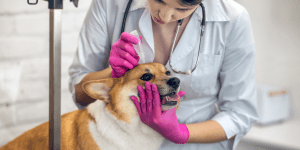Ear Mites in Dogs.
Ear mites are unfortunately fairly common in dogs, (and cats) and can easily spread from one animal to another. This Holidays4Dogs article will discuss what to look out for and what treatment is available for ear mites.
If you think your dog has ear mites you should seek veterinary attention sooner, rather than later. Some dogs can become pretty ill, hypersensitive and very uncomfortable if they are left untreated.  It is also highly contagious and can easily pass to other dogs and cats in the family.
It is also highly contagious and can easily pass to other dogs and cats in the family.
There are several different types of ear mites that can affect dog’s ears, but the most common one is called Otodectes cynotis.
In fact, they are one of the most widespread parasites found on dogs. These tiny, eight legged pests, can barely be seen with the naked eye.
However, they readily affect the dog’s ear canal, causing inflammation and discomfort in both the inner and outer ear. The infection stimulates wax production and typically produces a dark crumbly discharge from the ear.
Causes.
Ear mites are common cats. As a result, casual contact with outdoor cats is the most common way dogs can become infested with ear mites. Ear mites can affect dogs of all ages, types and breeds. However, dogs with dropped ears, such as Labradors and springer spaniels, can be more prone to infection due to the dark, moist conditions of the ear.
Symptoms of ear mites in dogs.
- Ear, or head scratching / rubbing the head on the carpet.
- Head shaking.
- Profuse waxy brown secretion.
- Unpleasant odour.
- Inflammation of the ear.
- Ear canal blocked with dark brown discharge. (You may just be able to visibly distinguish tiny white moving dots on the surface of the brown wax).
- Impaired hearing.
Treatment.
If the build of wax and secretions in the ear is severe, your vet will thoroughly clean them. If your dog is particularly difficult to handle, or in considerable discomfort, this may require him to be sedated. To confirm the presence of ear mites in your dog’s ears, your vet may take a swab.
Treatment for ear mites is applied directly into the ear canal and is usually repeated over a period of days, or weeks. It is important to complete the treatment.
Do not stop applying the medication, even if you think the problem appears to have cleared up.
It may also be recommended the outer skin areas are treated such as the neck and base of the tail. These are areas where ear mites can also thrive on the dog. Your vet may also prescribe an anti-inflammatory drug, or antibiotic to deal with any secondary infection.
It is important to remember to treat all animals in the household at the same time, especially any resident cats.
Complications.
Complications with ear mites can arise when the ear canal becomes so inflamed that the dog scratches intensely, causing blood vessels rupture. This can result in haematoma which will often then require surgery. It is also possible for the dog’s immune system to become so hypersensitive it can cause a severe allergic response.
Prevention.
Routine ear cleansing will help minimise the chances of your dog picking up ear mites. Always regularly clean bedding and periodically use a household spray; the sort that kills fleas (and flea eggs).


